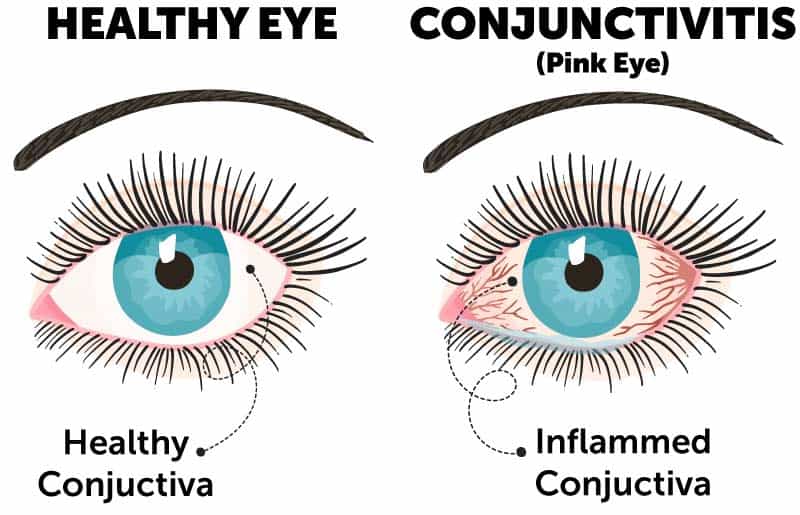Pink Eye (Conjunctivitis) - Inflammation or infection of the outer membrane of the eyeball and the inner eyelid.
Eyes are very delicate and sensitive. If there is a slight problem with them, then the symptoms start appearing immediately.
Conjunctivitis is one such common problem related to the eyes, which is called conjunctivitis in the medical language.
 |
| Pink Eye (Conjunctivitis) - Causes, Types, Symptoms |
It can occur in both acute or chronic form and it gets better on its own in two weeks.
But in many people, conjunctivitis causes severe symptoms that require immediate treatment.
Although this problem can happen to anyone at any time, it is more prone to happen in hot and humid environments.
Know What is Conjunctivitis? (Most common eye problem)
In our eyes, there is a transparent thin membrane, the conjunctiva, which covers the inner part of our eyelids and the white part of the eyeball, when it becomes inflamed or infected, it is called conjunctivitis or conjunctivitis.
When the small blood vessels in the conjunctiva become swollen, they become more clearly visible and the whites of the eyes appear red or pink. That's why it is also called Pink Eye.
Also Read:- Eye Specialist in Ahmedabad
The problem of conjunctivitis can be due to bacterial or viral infection or allergic reaction in the eye.
In young children, the problem of pink eye also often occurs due to not fully opening the tear duct.
It is a highly contagious condition, so it needs to be treated promptly.
What are the reasons?
Causes that lead to Conjunctivitis
Conjunctivitis can occur in newborns due to the blockage of the tear duct.
Infections, allergens, exposure to chemicals in other people can cause it.
Conjunctivitis Types
Viral Conjunctivitis
Most of these cases are caused by adenovirus. Apart from this, herpes simplex virus, varicella-zoster virus, and other viruses including coronavirus can also cause it.
Viral conjunctivitis often occurs in one eye, spreading to the other eye within a few days.
Bacterial conjunctivitis
Some bacterial infections also cause conjunctivitis. Conjunctivitis caused by both virus and bacteria is contagious.
It can be spread through direct or indirect contact with discharge from the eyes of an infected person.
Infection can occur in one or both eyes.
Allergic conjunctivitis
Allergic conjunctivitis can result from exposure to allergens such as pollen.
Exposure to chemicals
Symptoms of conjunctivitis also appear when the eyes come in contact with a chemical or any foreign object gets into them. But usually these symptoms get better on their own in a day.
Conjunctivitis Symptoms
Conjunctivitis can be very uncomfortable, but in very rare cases it affects vision.
It is highly contagious, and can spread very quickly to other people. So be alert if you see these symptoms:
- Red or pink appearance of one or both eyes.
- Burning or itching in one or both eyes.
- Abnormally excessive tearing.
- Watery or thick discharge from the eyes.
- Gritty feeling in the eyes.
- Swelling of the eyes, this symptom is usually seen due to allergic conjunctivitis.
Conjunctivitis Risk Factors
- Exposure to someone who has viral or bacterial conjunctivitis.
- Exposure to something you are allergic to (allergic conjunctivitis).
- exposure to chemicals; Such as coming into contact with the chlorine present in swimming pool water.
- using contact lenses; Especially keeping them on continuously for a long time.
How to stop the spread of infection?
- Do not touch your eyes with your hand.
- Wash your hands whenever necessary.
- Do not share your personal things like towel, pillow, eye cosmetics (eye makeup) etc. with anyone.
- Wash your handkerchiefs, pillow covers, towels, etc., daily.
- Under what circumstances should I consult a doctor?
- Severe pain in the eyes.
- Sharp prickling feeling in the eyes.
- Blurred vision
- sensitivity to light.
- Eyes become excessively red.
- the treatment
- Conjunctivitis occurs for many reasons, the treatment depends on the cause itself.
Conjunctivitis Treatments
- Viral conjunctivitis: There is no treatment available for viral conjunctivitis. Its symptoms improve on their own in 7-8 days. By the way, warm compress (immersing a cloth in lukewarm water and placing it on the eyes) provides relief in symptoms.
- Bacterial conjunctivitis: Antibiotics are the most common treatment for any bacterial infection. In bacterial conjunctivitis, the use of antibiotics eye drops and ointments (ointments/gels) can lead to normal and healthy eyes within a few days.
- Allergic conjunctivitis: In allergic conjunctivitis, there is swelling of the eyes along with other symptoms. Therefore, along with anti-histamine eye drops, anti-inflammatory eye drops are also given in its treatment.











Thanks for sharing such a nice blog with us. Keep Bogging! Just love to hear from you!
ReplyDelete